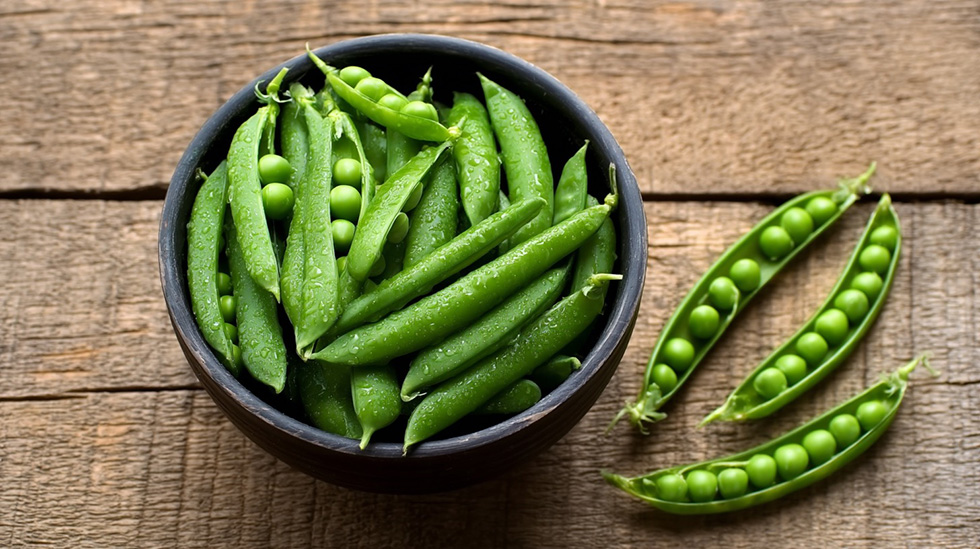Green peas – a small but big superstar on your plate 🌱
Green peas are known and loved by almost everyone – also known as garden peas or sugar snap peas. Its Latin name is *Pisum sativum* and it belongs to the legume family. Its origins can be traced back to the Middle East in Central Asia, where it was cultivated thousands of years ago. It was also eaten by the ancient Egyptians, Greeks and Romans, although it was mainly eaten dried. The fresh green peas we love so much today only became popular in European kitchens much later, after the Middle Ages.

Importance in the kitchen: 5/5
Green peas are one of the most versatile vegetables not only in Hungarian, but also in European cuisine. In soups, stews, salads, side dishes, purees – and that’s not even mentioning cream soups or rice with peas. And thanks to its frozen form, it’s available almost all year round and can be used in seconds. It has a place in almost every kitchen, from beginner to professional chef.
Which part is edible?
In green peas, the edible part is the pea pod itself, which is located in the pod. They are at their best when they are tender and not yet hardened. The pod is not edible in all varieties – for example, snow peas and pigeon peas are edible, but it is not recommended for regular green peas because they are fibrous and difficult to digest. When ripe, the pea pods are already drying out and are better used as dried pulses. The leaves and stalk are not edible.
Health benefits
Green peas are a vitamin bomb! Contains:
- Vitamin C – strengthens the immune system
- Vitamin K – helps blood clotting and bone health
- Folic acid – particularly important during pregnancy
- Iron, zinc, manganese – all contribute to the balanced functioning of the body
- Valuable fibre – improve digestion
According to folk medicine, green peas can also help regulate blood sugar levels and maintain cardiovascular health. It is also low in calories, making it ideal for dieters.
Production and season
Green peas are grown throughout Europe, mainly in the open air. Its season runs from late spring to mid-summer – in Hungary, fresh peas are usually available from May to July. The largest European producers include France, Germany and Poland. Hungary is also a major producer, especially in the southern lowland regions, where both fresh and frozen peas are of outstanding quality. For the rest of the year it is mostly available in imported or frozen varieties.
How to choose good green peas?
Choosing fresh green peas is not a fool’s errand, but there are a few things to bear in mind:
- The pod should be bright green, firm, shiny, not wilted or yellowish
- If you can, feel it: it should be firm but not hard – a sign of tenderness
- If you shake it slightly, you shouldn’t hear a rattling sound – this indicates that the eyes are not dry yet
Frozen is also a good choice, if it’s nice and green, not icy and doesn’t clump together, it’s a good quality.
Storage at home
Fresh green peas are a delicate beast – they lose their sweetness quickly after picking. Therefore:
- Store in a refrigerator, preferably in an airtight box or bag
- Stays at its best for a maximum of 2-3 days
- If you’re planning on a longer trip, it’s worth blanching (boiling briefly in cold water) and freezing – so you can store it for months
Pea trip around the world 🌍
Green peas are popular almost everywhere. In India they are part of spicy vegetable curries, in Japan they are fried in tempura, while in England “mushy peas” are one of the most classic side dishes for fish & chips. In France, “petits pois à la française” are made with butter and shallots, while in Italian cuisine, “piselli alla romana” are cooked with mint and onions. And in Hungary… who hasn’t eaten pea stew or pea tokány?
An iconic recipe: pea stew
The classic pea stew is made with milk, flour mash and a little dill, sometimes with a little sugar. It’s also perfect with fried eggs, meatballs or stews. An easy to prepare, quick, nutritious and a real “childhood dish”.
Kitchen tips, tricks and spices
The taste of green peas is sweet and mild, so they go well with a variety of spices. It is a perfect match:
- Parsley
- Dill
- Mint (mainly in Anglo-Saxon recipes)
- Butter, cream, onion, garlic
- Small doses of pepper, nutmeg
What is less suitable: spices that are too strong, such as curry or cinnamon, because they overpower the natural sweetness of the green peas. If you simply sauté it in a little butter or olive oil, it’s heavenly!
Summary
Green peas are a staple in Hungarian cuisine for a reason – they are full of flavour, colour, vitamins and memories. The next time you’re at the market or shop, don’t hesitate to pack a good portion, because this tiny green ball can create a lot of flavour! 🌿
